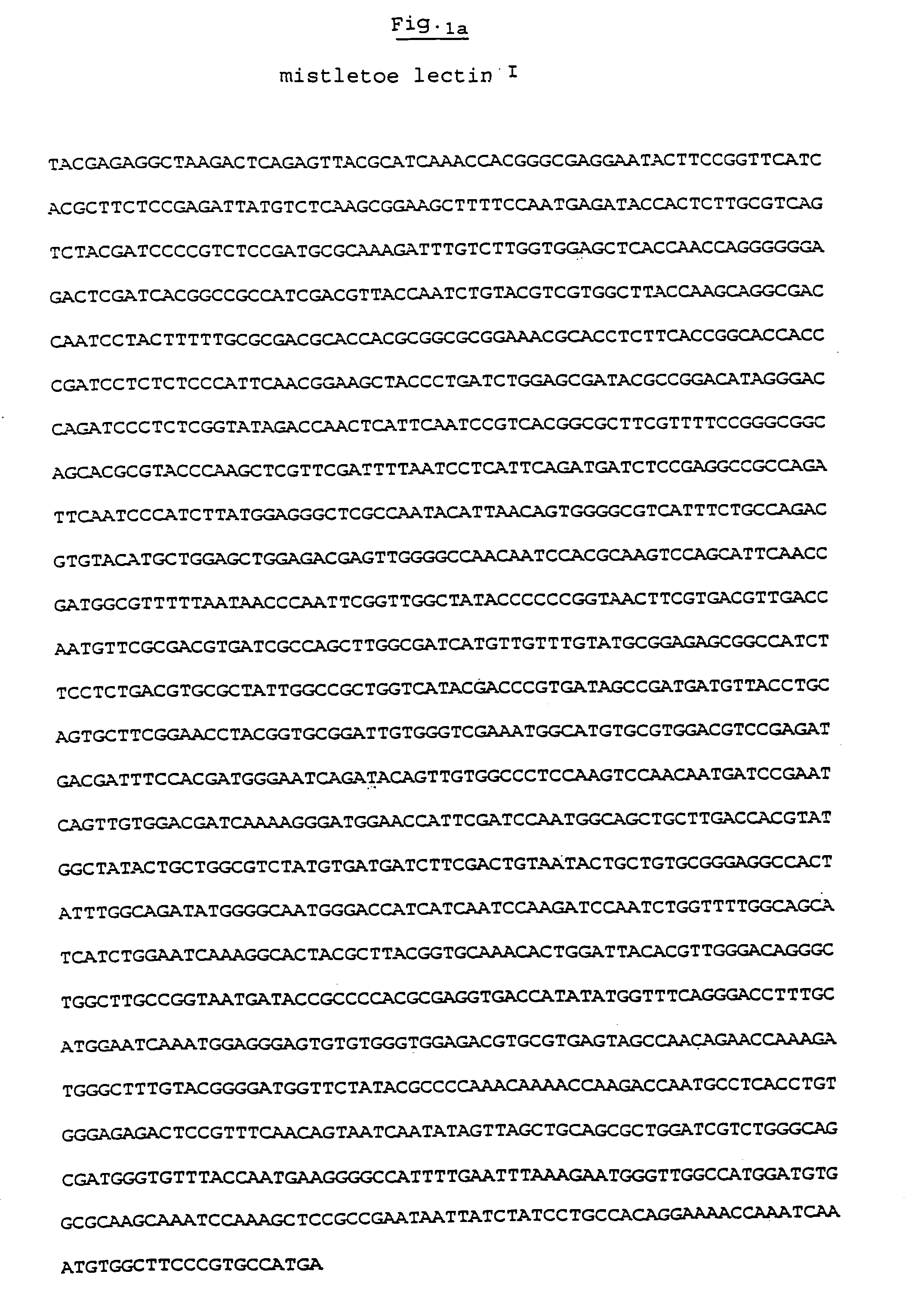Recombinant mistletoe lectin
- Summary
- Abstract
- Description
- Claims
- Application Information
AI Technical Summary
Benefits of technology
Problems solved by technology
Method used
Image
Examples
example 2
PCR Conditions for the Amplification of Mistletoe Lectin-I DNA
[0119]For the amplification of genomic mistletoe lectin-I DNA, 100 ng of template DNA, prepared as stated in Example 1, were used in a PCR process with 30 cycles using Taq polymerase (Boehringer Mannheim). 1 μg of primer, MgCl2 (end concentration 2 mM), nucleotide mixture A, T, C, G (end concentration 0.2 mM) and 2.5 units of Taq polymerase were added to the template DNA. The reaction was started as hot-start PCR by a denaturation step of the DNA for 5 minutes at 94° C. In this, the enzyme and the remaining reagents only mixed after a wax barrier between the components had melted. The 30 subsequent cycles are performed under the following conditions:
[0120]
Denaturation:94° C.30 secondsAnnealing:55° C.30 secondsAmplification:72° C. 1 minute
[0121]Following the 30 cycles, a 7-minute elongation reaction at 72° C. was also performed, before the reaction mixture was cooled down to 4° C.
[0122]The primers used in the PCR process h...
example 3
[0126]In order to determine the flanking 3′ and 5′ sequences of the DNA amplified in Example 2, the RACE technique was used. 2 μg of RNA template in cDNA synthesis buffer (end concentration: 20 mM Tris-HCl, 8 mM MgCl2, 30 mM KCl, 1 mM dithiothreitol; pH 8.5 (20° C.)) were treated with AMV reverse transcriptase, the deoxynucleotides and the specific primer (see below) and incubated for 60 mins at 65° C. Next, the sample was incubated for 10 mins at 65° C. After the purification of the first cDNA strand, the “tailing” reaction was carried out with ⅖ of the synthesised cDNA with terminal transferase. After the tailing reaction, a PCR was performed with the oligo-dT anchor primer and the specific primer (see above for incubation conditions, except for the annealing temperature, which was lowered to 50° C.). For the determination of the 5′ regions of the nucleic acid molecules amplified in Example 2, the oligonucleotide having the following sequence was used:
[0127]
CAC AGC AGT ATT ACA GTC...
example 4
Pharmaceutical Composition with Cytotoxic Action
[0131]Mistletoe, tobacco and rape cells are transfected with RNA vectors which code for MLA1 and MLA2, the respective cells are harvested after a few days, and the MLA1 and MLA2 proteins purified by affinity chromatography. As gel material, divinylsulphone (DVS)-activated lactose-coupled Sepharose 4B (Pharmacia) is used. By treatment with 0.2 M HCl, the material is activated, i.e. the Sepharose structure is partially hydrolysed and sugar-binding sites to which the lectins can bind are freed. 100 ml of gel material are washed with 0.2 M HCl in a Buchner funnel and suspended in 200 ml of 0.2 M HCl. The hydrolysis of the gel material is effected by 3,5-hour incubation of the suspension at 50° C. in the water-bath. The suspension is washed free of acid with water and then with peptide eluent (0.05 K2 HPO4×3H2O, 0.15 M NaCl, pH 7.0). Then the suspension is degassed, the peptide eluent removed by suction, and the viscous liquid gel material ...
PUM
| Property | Measurement | Unit |
|---|---|---|
| molecular weights | aaaaa | aaaaa |
| molecular weights | aaaaa | aaaaa |
| temperature | aaaaa | aaaaa |
Abstract
Description
Claims
Application Information
 Login to View More
Login to View More - R&D
- Intellectual Property
- Life Sciences
- Materials
- Tech Scout
- Unparalleled Data Quality
- Higher Quality Content
- 60% Fewer Hallucinations
Browse by: Latest US Patents, China's latest patents, Technical Efficacy Thesaurus, Application Domain, Technology Topic, Popular Technical Reports.
© 2025 PatSnap. All rights reserved.Legal|Privacy policy|Modern Slavery Act Transparency Statement|Sitemap|About US| Contact US: help@patsnap.com



